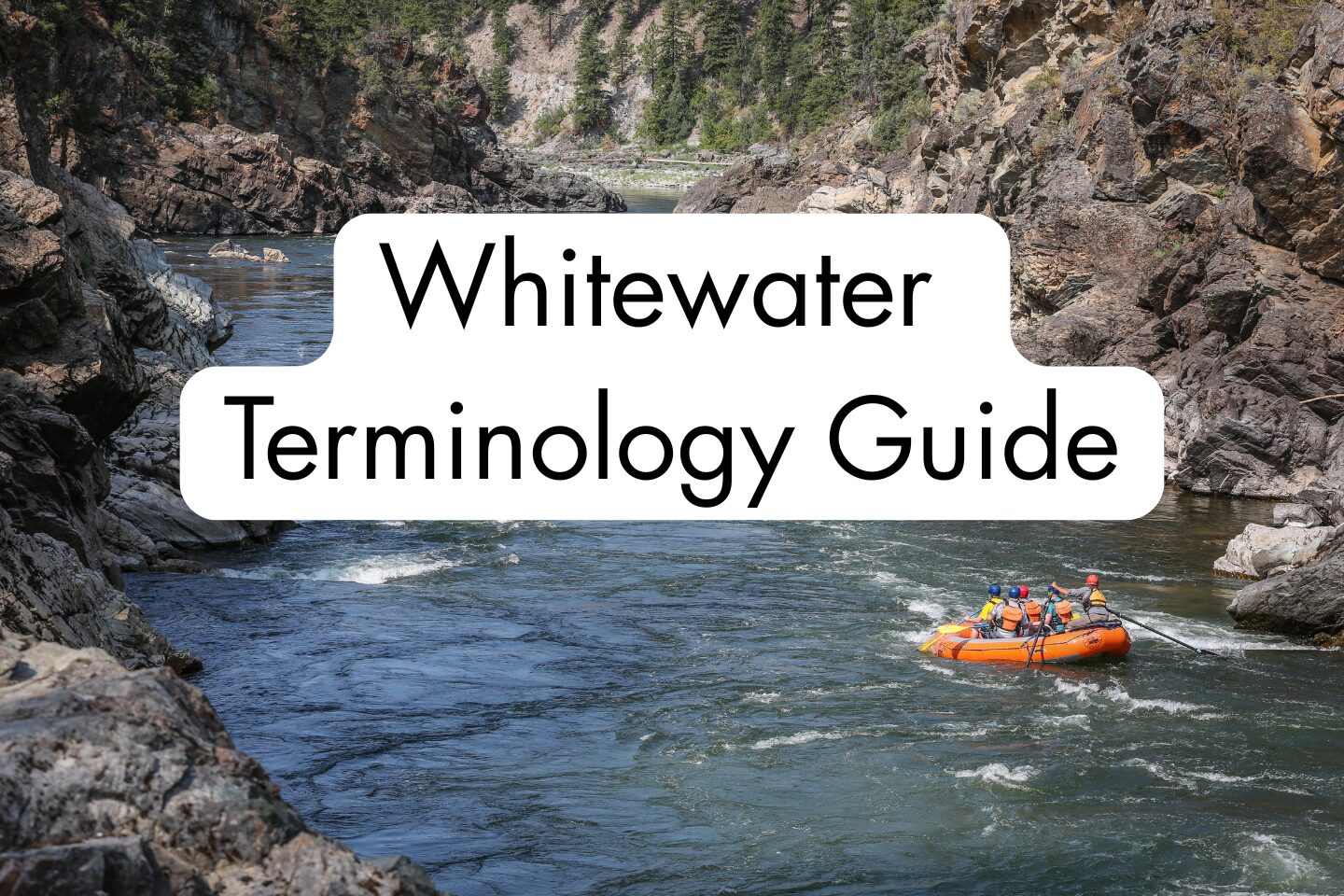Is it Whitewater rafting or white water rafting!? Missoula’s Whitewater Rafting Terminology Guide
Read on to find out! In this blog we’ll share definitions to commonly-asked questions we get during rafting trips on the rivers near Missoula. Educating people on all things rafting is something that we are passionate about.
Whitewater Rafting vs White Water Rafting
Technically, the grammatically-correct version would be whitewater as one word, and it is more-commonly used in the rafting industry. However, white water is the more-commonly used term, though, when people do Google searches to find white water rafting trips near Missoula.
Whichever version gets you rafting on the Alberton Gorge is the right way to spell it!
Paddle vs Row vs Oar
This is a fun one & can instantly make you sound like a pro…
You paddle with a paddle and you row with an oar. You do not oar your boat or row your paddle. A raft paddle has a large flat blade on one end, with a shaft in the middle and a t-grip on the other side. A kayak paddle is a shaft with a large flat blade on both sides, and an oar is a longer, thicker shaft with a larger flat blade on one end and a cylindrical handle on the other.
It sounds like a riddle, doesn’t it!?
Keeper Hole
Not all holes (or technically, hydraulic jumps) are keeper holes. We define keeper holes generally by their shape; a hole is a recirculation of water back up river formed by a rock or other unmoving obstacle in the river. A hole can have many different shapes, but usually we see them in a curve or smiley face.
So what is a keeper hole!? When that curve is upside down or “frowny” when looking at it from up river, you know you have a true keeper hole. When you see the frown, beware! This can trap people or gear in a recirculating current.
White Water Rapid
A whitewater rapid is usually formed by one or more of the following occurrences:
#1: gradient- the steepness of the river changes. #2: rocks or obstacles in the river. #3: constriction, meaning the river gets narrower, resulting in more turbulence. Many times it is a combination of these factors that form into rapids, but any of them can create one on their own.
When you think about the rivers near Missoula where you can enjoy guided white water rafting trips, you’ll encounter a variety of whitewater rapid experiences! For example, the Lochsa River has the most-intense white water rapids near us that you can raft. The Alberton Gorge also has some intense white water rafting, until water levels drop in late June/early July. When water levels drop the Alberton Gorge rapids are fun and splashy.
River Hazards
There are many forms of hazards on the river. Rivers are water flowing downstream, so we tend to think of hazards as unmoving objects in the water that could keep a boat or person stuck in one place. Wood, manmade objects (fences, rebar, cars, rope, etc), and rocks are the most common types of hazards we encounter.
River Classifications– What do the different classes of rivers mean?
Class I Rapids: moving water
Class II Rapids: moving water with features such as waves or even holes, generally with minimal consequences and no need to scout.
Class III Rapids: larger features such as waves, holes and rocks may be present, but in general our consequences are relatively low and the rapids are reasonably straight forward.
Class IV Rapids: introduces hazards in our main path or line that require a boater to make specific moves to ensure safety. We tend to see higher consequences in a flip or swim and scouting is recommended.
Class V Rapids: mandatory scouting, and boaters will encounter multiple scenarios where they must make certain moves linked throughout the rapid. There will be no swim zones and significant chances of injury or even death in the event of a swim or flip.
This is for advanced boaters and you will encounter powerful, pushy water.
Class VI Rapids: considered to be at the limits of current navigation capabilities and technology, or un-runnable (which means we don’t raft them).
Class VI rapids do get run from time to time, but when they are, they’re usually reclassified somewhere between a Class 5.1 and 5.9. That might sound like a small jump, but the difference between a 5.1 and a 5.2 is just as significant as the leap from a Class 4 to a Class 5. In other words, each decimal point marks a big increase in difficulty.
To break this down further, we tend to think of class I-III as beginner rapid classifications. You can look up the term “shoot the v, cut the c” to learn more about general whitewater basics. Class IV rapids are intermediate skill level required and the introduction of major hazards. Class V rapids are for advanced whitewater boaters. They require highly-technical skills, evaluation, adequate reaction time and experienced decision making. Class VI is generally considered un-runnable and should only be attempted by a team of expert and professional whitewater boaters with careful planning, ideal flows, safety considerations and highly-advanced skill levels.
These classifications serve as a starting point, but many factors can complicate rating a river. You can have class II lines with class V consequences. And certain rivers, such as the Grand Canyon, may use different classification systems like 1-10. This may cause confusion if you’re familiar with the Class I-VI ranking we just described.
Bottom Line: All moving water should be considered potentially dangerous, respected and safety precautions should be taken.
Pin
A raft or kayak pinned in place to a rock or obstacle by the force of the water.
Flip
If you hear someone say “we flipped, they mean their boat flipped fully upside down.
Clean Line Principle of Rafting
The goal of the clean line principle is to minimize the potential for snagging your gear or clothing on something that could which could lead to an entrapment. You want to keep your gear and clothing as streamlined and uncluttered as possible.
You shouldn’t have any items that are loose enough or long enough to allow for a closed fist to enter it and potentially become entrapped.
Foot Entrapments On The River
A foot entrapment is when when your foot gets stuck on a feature on the bottom of the river, perhaps on a rock or other obstacle. This can be a serious issue that you want to avoid because the swift current can push you down river. It happens quicker than expected, so take a moment to review this section.
How To Avoid A Foot Entrapment: As a basic rule do not stand up or put your feet down when you are in moving water that is above your knee level. While swimming or floating in moving water keep your feet up and pointed downstream. We like to say float on your back, nose and toes upwards & pointed downstream.
PFD
PFD means personal floatation device. A properly-fitted PFD should be worn at ALL times in swift water. Did you know that there are different types of PFDs for different activities? You wouldn’t want to use a life jacket that you use at the lake on the river, for example.
Always wear your PFD, even as a professional. One great reason why is that many times we boat with people who have different skill levels. If we as experts do not wear our PFD, we are teaching others who look up to us or admire our skills that this behavior is ok. As an expert river runner you can set a good example for others and help make our sport safer- most fatalities occur when not wearing a PFD.
Missoula’s Whitewater Rafting Terminology Conclusion
This is just a few of the whitewater terms that you may encounter while rafting. There are many more concepts to study when learning about whitewater rafting. Ready to learn more? Schedule a private river instruction session with Zoo Town Surfers. Our team will help you dial in your gear and increase your skills as a boater.

